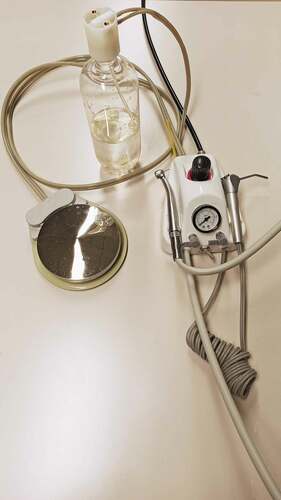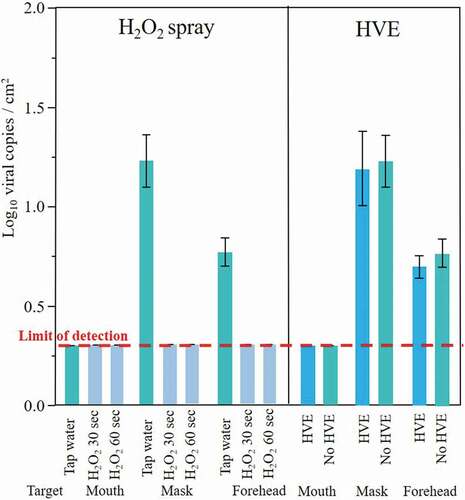Figures & data
Figure 1. Setup of the custom-built Class III-like air-tight glove box with chamber pressure control. Three accesses for gloves are shown on the front panel, one created at the center of the door. Between the glove apertures, two digital manometers and a backup analog manometer measured the negative pressure inside the chamber (right digital manometer and analog manometer) and the differential pressure inside the mouth of the operator phantom when a mask covered its mouth and nose (left digital manometer). On the upper right corner of the chamber, the two air leak valves are visible for pressure control. The control apparatus operating the air turbine is located on the right part of the upper panel, having attached the pressurized water tank to generate the air-water cooling spray for the turbine handpiece. The chamber is still to be connected to an oil-free air compressor, HVE line, and two low-vacuum pumps, here not shown

Figure 2. Presentation of the air turbine and control apparatus used in the present study. The pressurized water tank used to generate the air-water cooling spray for the turbine handpiece is seen on the upper part. The handpiece cord was afterwards inserted inside the chamber and sealed, for the turbine to operate inside the patient phantom

Figure 3. The two phantoms inside the chamber are shown. On the right the patient phantom is situated, having the air-turbine and HVE tip fixed in the same position throughout all experimental runs, as if operated by a right-handed dentist and dental assistant. On the left, the operator phantom equipped for the first experimental run, with a surgical mask and the first target fixed with double-sided adhesive tape on its forehead. The external area of the mask to be assessed for viral contamination can be seen marked in red. In all runs, the chamber space between operator and patient was left free of materials and protruding gloves to allow for an even aerosol spread, similarily to clinical conditions

Table 1. Results (mean±SD) of the log-transformed viral copies per square centimeter for each experimental run and target. Different letters indicate significant differences between groups: e.g. the values with the letter ‘a’ are significantly different from those with the letters ‘b’ or ‘c’ (Tukey’s test, p < 0.05)
Figure 4. Graph showing the results of the experimental runs (mean Log10 viral copies/cm2 ± 1SE). Results are divided by the aims of the study, that is to compare the efficacy of high-vacuum suction (HVAC) and the addition of 0.5 vol% hydrogen peroxide to the cooling spray of the dental handpiece (H2O2 spray) in mitigating coronavirus spread by aerosol. Experimental runs using HVE were performed using surgical mask, while runs using H2O2 spray were performed using surgical mask and turning off the HVE

